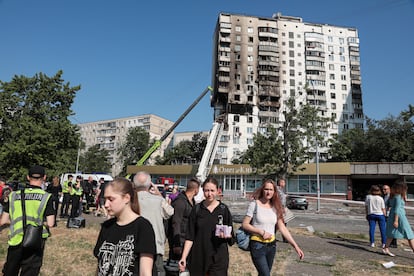Seismographs record tremors from the war in Ukraine
Technology designed to detect nuclear tests thousands of miles away can capture explosions of all sorts — whether they are bombs, missiles or gunfire — in targeted cities

Propaganda and disinformation cannot fool seismographs. Designed to detect earthquakes, these devices pick up any terrestrial disturbance, whether it’s a volcanic eruption, a mining survey, a soccer goal, or a drill in a quarry, Now, we know they also register the bombs and missiles dropped on Ukraine. In a groundbreaking paper published in the prestigious journal Nature, a group of researchers demonstrates how a seismological network designed to detect nuclear tests thousands of miles away can also pick up explosions from the war in Ukraine. There are far more of those than either side acknowledges.
The Comprehensive Nuclear Test Ban Treaty devised a monitoring system for this purpose (the agreement itself has yet to be enforced because some of the signatory countries have not yet ratified it). Still incomplete, it is based on a network of seismic stations set up around the world to track any country that fails to comply with the treaty. To do so, the participating states had to deploy a set of seismographs with a particular topology that could detect a nuclear explosion, however deep or far away it might be. As with the other networks, the data is sent to Vienna, Austria, where the new agency’s headquarters are located, for signal analysis. The Ukrainian portion, which consists of 24 seismometers deployed as a grid with a two-kilometer space between each pair, is located about 60 miles northwest of Kyiv, near the town of Malyn, hence its name: Malyn AKASG. From 7,000 kilometers (4,350 miles) away, it has detected the six nuclear tests conducted by North Korea since 2006. It also picked up the enormous explosion at Lebanon’s port of Beirut in the summer of 2020 and even registered some meteorite impacts. But could it detect the bombs falling much closer to home?
As a group of experts in detecting terrestrial disturbances show in their article in Nature that seismographs can be the perfect whistleblowers during a war. There is a lot of noise in them; of that noise, only a few sources can be detected from a distance. Exit explosions, when a projectile is fired, ballistic shock waves and detonation after impact all release enough infrasonic energy, but only the latter can generate detectable seismic energy.
Ben Dando is the director of the verification department at NORSAR (Norwegian Seismic Array), an independent Norwegian organization whose mission is to detect seismic disturbances, particularly suspected nuclear testing. Along with his colleagues at this institution, the University of Oslo and the Ukrainian space agency, Dando has analyzed everything captured by Malyn AKASG between February 24 (when the war started) and November 3, 2022. In that span, the system captured 1,282 explosions in three regions of Ukraine, including Kyiv, where the system was most sensitive. “In April alone, the number of declared events is about half of what we detected in the seismic data,” Dando says in an email.
“The number of reported events is about half of what we detected in the seismic data.”Ben Dando, the director of NORSAR’s verification department
Seismicity plots provide a glimpse into the course of the war. The highest concentration of explosions occurred in the initial months of the Russian offensive, between February and April of last year. At the end of that month, the Russians retreated to the positions they now hold. Since then, the number of events has remained at a tenth or less of what it was at the beginning of the war. “We still monitor Ukraine constantly, and we continue to detect explosions. However, the rate of detection is not as high as it was when the invasion began, as most of the activity is now concentrated in southeastern Ukraine, where the coverage is not as good for the currently available data.”
The work shows that the seismicity caused by the explosions is concentrated in cities. At least during this phase of the war, there are no large explosive charges on the front lines. There are remote attacks on urban areas such as Kyiv, Chernihiv, Bucha and Malyn itself. With the exception of the invasion’s first three days, the Malyn AKASG seismographs have always detected events beyond the ones admitted to by the warring parties.
Researchers also attempted to determine the type of weapon used and its explosive charge based on the seismic magnitude recorded. The problem is that what little scientists know comes from nuclear explosions, which are very intense but also occur thousands of miles away. Moreover, for decades these tests have been carried out at depth, which complicates comparing them with surface explosions. “We cannot identify the exact type of munition used today, but we hope to be able to do so in the future by seeing if different munitions generate unique characteristic signals,” says Dando. However, he notes, “we can say something about the relative size of the explosions, and we know that different munitions have different explosive yields. Most bombs have an explosive yield of about 10 kilograms, while larger missile strikes can have an explosive yield of hundreds of kilograms.”
Malyn AKASG exists elsewhere, too. For instance, Spain has its own Malyn AKASG located in Sonseca, Toledo. Like the Ukrainian one, it is a network of seismographs with a specific topography. Javier Fernández, of Spain’s National Geographic Institute’s (IGN) nationwide seismic network, explains: “They are clusters of seismographs capable of detecting very distant signals at very low intensity.” To do so, the web of devices allows the signal to be amplified and differentiated from the background noise.
In addition to earthquakes, the IGN seismographs located at 100 stations nationwide detected the 2021 eruption of the La Palma volcano, the 2018 explosion of pyrotechnics in Tui and even Spanish soccer player Andrés Iniesta’s 2010 World Cup final goal. “The noise has its own profile, the activity of factories, cars... during the [Covid-19] lockdown, the seismographs stopped recording that noise,” says the IGN researcher. Of the article, Fernandez emphasizes that it can become a system for avoiding propaganda and disinformation: “Seismic data could become an additional layer of data against what [others] want to you to believe.”
Sign up for our weekly newsletter to get more English-language news coverage from EL PAÍS USA Edition
Tu suscripción se está usando en otro dispositivo
¿Quieres añadir otro usuario a tu suscripción?
Si continúas leyendo en este dispositivo, no se podrá leer en el otro.
FlechaTu suscripción se está usando en otro dispositivo y solo puedes acceder a EL PAÍS desde un dispositivo a la vez.
Si quieres compartir tu cuenta, cambia tu suscripción a la modalidad Premium, así podrás añadir otro usuario. Cada uno accederá con su propia cuenta de email, lo que os permitirá personalizar vuestra experiencia en EL PAÍS.
¿Tienes una suscripción de empresa? Accede aquí para contratar más cuentas.
En el caso de no saber quién está usando tu cuenta, te recomendamos cambiar tu contraseña aquí.
Si decides continuar compartiendo tu cuenta, este mensaje se mostrará en tu dispositivo y en el de la otra persona que está usando tu cuenta de forma indefinida, afectando a tu experiencia de lectura. Puedes consultar aquí los términos y condiciones de la suscripción digital.
More information
Archived In
Últimas noticias
From Hungary’s Orbán to Chile’s Kast: How Trump helps turbo charge the far right
Magnets in their heads: How some animals guide themselves using the Earth’s magnetic field
From Andorra to Gibraltar, a black market for Ozempic exploits its success: ‘They’re the most sought-after products in the world’
From safe-haven investment to geostrategic weapon: Who owns the most gold and where are the bars kept?
Most viewed
- Why we lost the habit of sleeping in two segments and how that changed our sense of time
- Trump’s obsession with putting his name on everything is unprecedented in the United States
- Charles Dubouloz, mountaineering star, retires at 36 with a farewell tour inspired by Walter Bonatti
- Venezuela faces its most tense Christmas yet
- CBS in crisis after pulling a report on Trump’s deportations to El Salvador (which later leaked online)











































